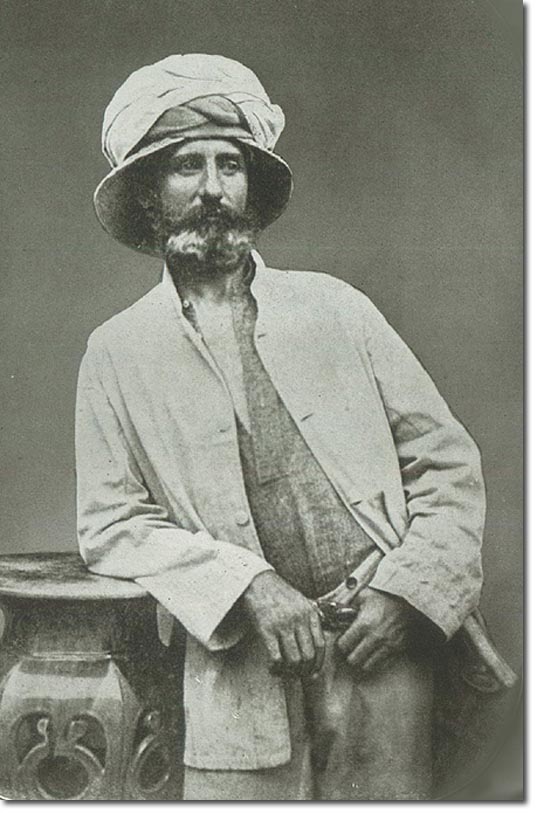|
|

 |
|
This photo was published in CRB Barratt's history of the 7th Hussars (1914) simply titled LIEUT.-COLONEL HAGART (In 'Mutiny' Kit). It is also published in the Tercentenary Edition of the regiment's own brief history, The Queen's Own Hussars (1985) but titled Lieutenant Colonel Charles Hagart in "Mutiny" kit.
In 1858, when the 7th Hussars were fighting rebels in India, the regiment was commanded by the two Hagart brothers; Colonel Charles Hagart and Lieutenant-Colonel James Macaul Hagart. Barratt's history is quite confusing on the issue but it seems clear that Charles, the elder brother, was promoted to Lieut-Colonel on 31st Oct 1851 and commanded the 7th until his brother James was promoted to Lieut-Colonel in August 1857. They both travelled to India in 1857, James, in command of the regiment, sailed with his men on the 'Lightning' while Colonel Charles Hagart and Veterinary Surgeon J Barker, with 2 sergeants travelled overland to select horses for the regiment. The 'Lightning' took 3 months to reach Calcutta but we are not told how long Charles took to ride overland to India. The first mention of Charles in India is on 18th Jan 1858 when he was in command of the regiment as it marched from Allahabad to Cawnpore. The regiment split up in February, the left wing going to Meangunge, and two squadrons and HQ going to Alumbagh under 'Colonel Hagart'. It would be natural to assume that Barratt is talking about Charles while James would be referred to as Lieutenant-Colonel Hagart. But later on James is referred to as Colonel James, for on 19th March, in the relief of Lucknow, the action at Musa Bagh is described and how the rebels took refuge in a nearby village: 'Under the command of Colonel James Hagart of the 7th a troop of the regiment, 2 guns and a few men of the 78th were sent to dislodge them. The guns were brought up and opened fire. Two shells had exploded in the fort when out dashed about 50 of the enemy and made straight for the guns. Three officers of the troop were wounded, Slade, Wilkin and Bankes, the latter mortally, as had already been stated. 'Colonel Hagart's gallant effort to save Bankes, who was being hacked at by the rebels as he lay disabled on the ground, so far succeeded in that officer was rescued, though only to die of his wounds a few days later. Colonel Hagart's condition after the melee is thus related by Sir Hope Grant: "Everything about him bore traces of his gallant struggle. His saddle and his horse were slashed about both in front and behind, his martingale was divided, his sword-hilt dented in, the pocket-handkerchief severed as clearly as with a razor, and a piece of the skin on his right hand cut away." Sir Hope Grant recommended Colonel Hagart for the VC but Sir Colin Campbell declined to forward the application on the ground that his rank was too high.' The photograph is surprising in that the commanding officer chose to be portrayed in such a relaxed way, and dressed in such an unmilitary 'kit'. The headgear seems to combine two turbans with the type of neck protector issued to some units in tropical climates. It seems incredible that this and other contemporary pictures show soldiers wearing headgear that does not have a peak to shade the eyes. The beard was normal for soldiers serving in the Indian Mutiny, especially since the Crimean War of 1854-56 had made beards acceptable. The white jacket is probably not regulation; it looks like a cool canvas jacket worn in the summer months with a vest underneath, daringly unbuttoned. The white trousers are held up by braces and he has his thumbs hooked into his sword belt, the sword being just visible behind him. There is no sign of injury to his hand so the photo was taken either before March 1858 or on his retirement in November of that year. James entered the regiment as a cornet on 20th May 1837, five years after his brother Charles so it may be that there was a 5 year difference in age. He was given the CB on 26th July 1858, perhaps to compensate for not getting the VC. He retired by sale of his commission on 12th November 1858 and on that date Sir William Russell became Lieutenant-Colonel commanding. |
Regimental details | Commanding Officers
Armed Forces | Art and Culture | Articles | Biographies | Colonies | Discussion | Glossary | Home | Library | Links | Map Room | Sources and Media | Science and Technology | Search | Student Zone | Timelines | TV & Film | Wargames
